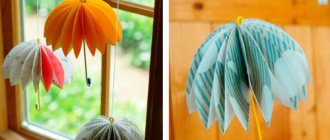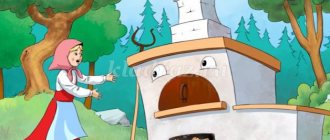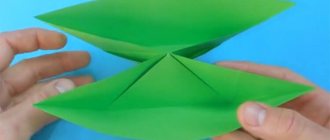Long-term plan for manual labor in the preparatory group
Evgenia Barutkina
Long-term plan for manual labor in the preparatory group
1. Long-term work plan for the circle
in the preparatory school group
No. GCD Purpose Material
October
1 "Autumn"
paintings" Teach children to create plot compositions, cultivate a desire to preserve the beauty of nature in arrangements and floral compositions. Leaves of various trees and shrubs, herbs, flower petals, seeds, colored cardboard, glue, tassels, napkins, oilcloths, composition options.
2 "Fairytale Heroes of the Forest"
Continue teaching children to work with natural materials. Teach children to make crafts based on drawings, combine different materials in one craft, and fasten them together using sticks and plasticine. Develop creative imagination, fantasy, cultivate artistic taste, patience, attention, observation. Spruce and pine cones, ash wings, down and feathers of birds, moss, various seeds. Demonstration drawings with crafts.
3 Collective work “Golden Autumn”
Teach children to create plot compositions, cultivate a desire to preserve the beauty of nature in arrangements and floral compositions;
Develop the ability to create teamwork by discussing details. Leaves of various trees and shrubs, herbs, flower petals, seeds, colored cardboard, glue, brushes, napkins, oilcloths, composition options.
4 Modeling toys according to children’s ideas Teach children to independently select a topic for work, using their existing experience in creating crafts from natural materials. A variety of natural materials, plasticine, wire, stacks, planks.
November
1 "Magic plates"
Develop a sense of form, color and composition; creative imagination, artistic taste, creative initiative Paper plate,
colored paper, paints
glue, scissors, sample.
2
"In Grandma's Yard"
Create a collective model of a village yard using origami techniques. Develop children's spatial imagination, strengthen the ability to follow oral instructions; develop concentration and creativity Colored paper, scissors,
pencils, cardboard box, scraps of fabric
3
4 "Doll made of colored yarn"
Teach children the simplest way to transform yarn into a souvenir doll, and independently use the decorative elements of a craft. Colored yarn, scissors, colored paper, glue, sample.
December
1 "The Long-awaited Guest"
Teach children to make a three-dimensional Christmas tree from a cone and colored strips of the same length. Colored paper (green, cardboard, scissors, glue, sample.
2
"New Year's toys"
Strengthen children’s previously acquired skills in working with paper, glue, and scissors; develop a sense of form, color and composition; develop creative imagination, artistic taste, creative initiative Colored paper; cardboard templates of geometric shapes; scissors; braid for making loops; glue; tassels; paints; jars of water; napkins, corrugated paper, confetti.
3
4 "Volume snowflakes"
Teach children to make a three-dimensional snowflake and connect the parts. Develop creative imagination, fantasy, cultivate artistic taste, patience, attention, observation. White paper, glue, pencil, scissors, loop tape, sample.
January
1
"Winter's Tale"
Create a collective panel. Teach children to crumple small pieces of paper, glue them onto templates, thereby developing fine motor skills, develop creative imagination, fantasy, and use different techniques for working with paper and cotton wool. Strengthen children's previously acquired skills in working with paper, glue, and scissors. Whatman paper A3, pencil, colored paper, napkins, serpentine, corrugated paper, foil, cotton wool, cotton pads, glue, scissors.
2
3 "My first bookmark"
Develop thinking, spatial imagination, memory, fine motor skills and speech. Colored paper, pencil, scissors, glue, sample.
February
1 Greeting card for Defender of the Fatherland Day. Learn to think about the content of a postcard, use a variety of cutting techniques. Learn how to beautifully arrange an image on a sheet of paper. Sheets of thick paper, templates, colored paper, scissors, glue, brush, braid, oilcloth, sample
2
3
Gift for mom. Continue to teach children how to make three-dimensional crafts. Colored, white, corrugated. paper, scissors, glue, pencil, openwork braid, tassel, sample.
4
March
1
"Little Beads"
Introduce children to this type of artistic creativity, such as beadwork, and teach them how to make a simple bead decoration. Develop imagination, fine motor skills, coordination of movements, finger flexibility, which is directly related to speech and mental development, teach concentration and diligence. Multi-colored beads of different sizes, thin fishing line (thread, scissors.
2
3 "Blooming tree"
Teamwork.
To consolidate children's previously acquired beadwork skills. Teach cooperation and careful execution of crafts.
Multi-colored beads of different sizes, thin fishing line (thread, wire, scissors, stand for “tree”, gouache paint, gauze, plaster, glue, brush. 4
April
1
2 "Easter Bunny"
Making
a “bunny box”
for an egg using the origami method and coloring an Easter egg. To develop in children the ability to work with their hands, to accustom them to precise finger movements under the control of consciousness; develop spatial imagination, strengthen the ability to follow oral instructions; develop concentration and creativity. Colored paper, glue, pencil, scissors, brush, eggshell, paint, sample.
3
"Miracle Curl"
Introduce children to a new type of working with paper - quilling. To develop in children the ability to work with their hands, to accustom them to precise finger movements, to develop spatial imagination, to consolidate paper rolling skills, to develop concentration and creativity. Quilling paper of different colors, pencil, scissors, cardboard, glue, sample.
4
May
1
Greeting card for Victory Day Learn to think about the content of the card, use a variety of cutting techniques. Learn how to beautifully arrange an image on a sheet of paper. Colored paper, colored cardboard, pencil, scissors, glue, sample.
2
3
"Whisper of the Sea"
Continue to teach children to work with natural materials - shells. Teach children to make crafts based on drawings, combine different materials in one craft, and fasten them together using plasticine. Develop creative imagination, fantasy, cultivate artistic taste, patience, attention, observation. Shells of different types, plasticine, beads for eyes. Demonstration drawings with crafts.
4
Designing “Trees” from paper (preparatory group).
Author: Andryushchenko Anastasia Nikolaevna
Educational institution: MADO No. 26
Location: Kemerovo, Kemerovo region
Topic: Designing “Trees” from paper (preparatory group).
Library Section: Lesson Developments
Publication date: 03.04.2019
Relevance: The public of the city of Kemerovo is widely discussing the issue of the future fate of the relict forest area Sosnovy Bor. Many citizens express their position through creating petitions, collecting signatures, and publishing on social networks. It is very important to make children aware that every citizen can participate in making decisions that affect the entire city.
Goal: Learning to design various types of paper trees.
Tasks:
To introduce your hometown, its nature, to cultivate patriotic feelings of empathy and inclusion in the life of your city.
Improve skills in working with scissors, accuracy and precision in working with paper,
Continue teaching how to use a dictionary and practice reading
Progress of the lesson
Guys, we have Sosnovy Bor in Kemerovo. Who's been there? And who can answer Is Sosnovy Bor a forest or a park? Sosnovy Bor is located almost in the center of the city and occupies a large area (video) And when is a place for a walk called a park? We can’t answer this question exactly... what do educated people do when they realize that their knowledge is inaccurate? (check in the dictionary).
But who wants to read for themselves and accurately answer what is called a park? (A park is a large garden and a planted grove with alleys, flower beds, etc. A grove is a small, usually deciduous forest.) Can you and I build a park? What will you build in the park? (Gazebo, carousel, etc.) (the teacher places it on the table, draws lines with a pencil) So paths, paths, paths will be trampled... Will there be beauty? what about the amenities? Will not be. It will be both inconvenient and ugly. That’s why architects say: “The park needs to be laid out: alleys should be created (the gesture of drawing an alley), some squares should be designed, with fountains or gazebos...” And what else is needed in the park? (trees) Of course, what kind of park is this? what if there are no trees? We'll line the main alley with fir trees, and the side alley with trimmed linden trees... Or maybe we'll plant groves somewhere... Birch trees would be nice...! And you can make trees (the teacher quickly shows the finished workpiece and makes the desired tree shape from the workpiece). And in a regular park, trees were trimmed in different shapes (cubic, triangular, round...(showing pictures of a regular and landscape park).
Let's stand in a circle, close our eyes and imagine ourselves as trees. (music sounds of the forest sounds). What kind of trees are you, what would you tell park visitors?
I propose to make two workshops. in one we will make trees like this (demonstration). In another one like this (show). First I'll explain how to make each tree. See how to make FIR. I fold the triangle in half. I make slanted cuts like this. Now I unfold the triangle and begin to bend the branches: I press my finger on the fold line at the top and turn the branch out. I press the branch so that the paper remembers the folds. I skip one branch and press on the next fold... and so on until the end. Then I put the finished tree on the table and iron all the folds again.
See how to make a LEAVED TREE. 3-4 rectangles folded together are stapled together like a book. Then we close the book, take it by the fold line and cut out the silhouette of the tree by eye. Like this: stand, trunk, crown. Now we unfold the book and place the tree. I'll clean up my workplace.
Whoever wants to make a spruce will stand on the left, and whoever wants to make a deciduous tree will stand on the right.
What do we need?
The game “There was a birch tree in the field” while the attendants are preparing the group for the lesson. Children take places at the table, prepare everything they need for work. Trees are made. They clean up the workplace and put their own trees in the place of the proposed park.
We have a park. Now guys, let's remember the video. What did Sosnovy Bor look like? Does it look like a park? I suggest you think about it and take part in the discussion along with other Kemerovo residents: Should Sosnovy Bor be left, preserving its pristine nature, or should the green area be improved, making it convenient for visiting: add sculptures, pave paths, etc. It's time for us to go for a walk, we will answer this question when we return to the group.
Work plan for labor education in the preparatory school group
Taisiya Kozlovtseva
Work plan for labor education in the preparatory school group
LABOR EDUCATION
month September
1. Work in a corner of nature : watering indoor plants.
Task: consolidate knowledge about the need for daily watering of flowers.
2. Labor in nature : cleaning a group site .
Task: to continue to educate children to want to participate in joint activities.
3. Work in a corner of nature : inspection of indoor plants.
Task: we consolidate knowledge about indoor plants and the features of caring for them.
4. Game - competition “The best canteen attendant”
Task: learn independently, without an adult’s reminder, to perform the duties of an attendant; plan your activities in pairs.
5. Work in the book corner : glue up torn books.
Task: to continue to cultivate a caring attitude towards books.
October
1. Duty in a corner of nature.
Task: we strengthen children’s ability to pay attention to the sequence of actions when caring for plants.
2. Canteen duty.
Objective: strengthen the ability to independently and conscientiously perform duties.
3. Story-based role-playing game “Builders”
Task: to cultivate cognitive interest in the work of adults .
4. Labor assignment : we bring order to the group site .
Task: we continue to instill in children the desire for order.
5.Self-service: exercise “Let’s help Pinocchio get dressed”
.
Objective: strengthen children’s ability to dress and undress independently.
november
1. Household work : Game - competition “Keep everything clean”
— Objective: to consolidate the ability to notice disorder and eliminate it;
continue to teach how to use the cabinet compartments for their intended purpose; cultivate a caring attitude towards things, a habit of order.
2. Household work : washing toys.
Task: we form children’s knowledge about the purpose of this work , strengthen the ability to outline a work plan .
3. Labor in nature : preparing shrubs for winter .
Task: to consolidate knowledge about the need to raking leaves to the root of the bush.
4.Self-care: “Locker room”
.
Task: Invite children to hold the next stage of the competition for the neatest cabinet.
5. Household work : we wipe down the shelves of the cabinets.
Task: we continue to strengthen the ability to do work independently .
December
1. Labor assignment : clearing paths to the feeding trough, insulating tree trunks with snow.
Task: invite children to figure out how to complete two tasks at the same time.
2. Labor in nature : removing snow from buildings
Task: invite the children to look around and tell where snow is needed.
3. Household work : we bathe dolls.
Task: invite children to include this labor operation in one of the s/r games.
4. Household work : washing doll clothes.
Objective: to expand the experience of labor actions .
5. Canteen duty.
Task: consolidate knowledge on table setting.
January
1. Duty in a corner of nature: exercise “Flower Island”
.
Task: we consolidate the ability to observe plants and follow the rules of caring for them.
2.Self-care: exercise “shoe rack”
.
Objective: to deepen children’s understanding of the rules of shoe care.
3. Household work : cleaning in the music education .
Task: we strengthen children’s ability to carry out work assignments that extend over time.
4. Labor in nature : setting up a feeder for wintering birds.
Task: invite the children to tell them what they know about hanging feeders and find a suitable place for it.
5. Labor assignment : feeding birds on the site.
Objective: consolidate knowledge about choosing food according to the birds.
February
1. Canteen duty.
Objective: increasing the independence of children at each stage of duty.
2.Self-service: game situation “Locker room”
.
Objective: to consolidate the ability to dress independently in a certain order.
3. Labor in nature : we will free shrubs and young trees from snow.
Task: strengthen children’s ability to carefully free branches from snow.
4. Duty in a corner of nature: loosening the soil of indoor plants.
Objective: to expand the understanding of labor actions in caring for plants.
5. Household work : we wipe the chairs.
Task: we continue to form a conscious attitude towards order and act together.
March
1.Self-service: type of activity “I do it myself”
.
Objective: to improve children's self-care skills: drying clothes, cleaning shoes.
2. Duty in a corner of nature.
Objective: to generalize and supplement knowledge about the conditions necessary for plant life.
3. Work in a corner of nature : experience “Water Purification”
.
Task: consolidate children's knowledge about various methods of water purification.
4. Labor in nature : clearing paths to the group site .
Objective: to improve children’s labor skills in working with various equipment.
5.Self-care: exercise “I do everything myself”
.
Task: we continue to form healthy habits.
April
1. Labor in nature : Collecting broken branches on the site.
Task: to create a desire to work together .
2. Labor in nature.
Task: we consolidate children’s knowledge of choosing work assignments based on their interests.
3. Household work : gluing boxes.
Objective: to improve the ability to perform relevant labor operations .
4. Labor in nature : cleaning the site.
Task: we continue to form a responsible, owner-like attitude towards our site.
5. Duty in a corner of nature: game situation “Flower Island”
.
Objective: to continue to improve children's plant care skills.
May
1. Work in nature : Spraying indoor plants with water from a spray bottle.
Task: to reinforce children’s understanding that leaves also need moisture; cultivate a caring attitude towards plants.
2. Canteen duty.
Task: strengthen the ability to set the table independently.
3. Household work : cleaning the group room .
Objective: strengthen the ability to negotiate the distribution of responsibilities.
4. Labor assignments : weeding a flower bed on the site.
Task: we continue to develop labor skills , teach them how to prepare a flower bed for planting.
5. Work in the book corner : repairing books.
Task: to help children divide into working groups based on interests .



